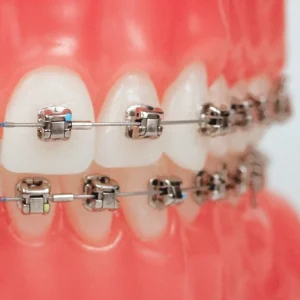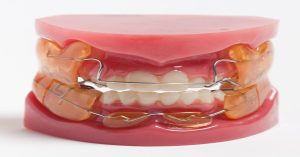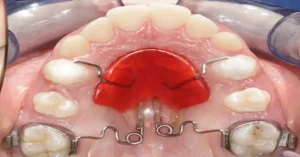Key Takeaways
- Accelerated orthodontics blends traditional braces/aligners with advanced techniques to reduce treatment time.
- Common methods include micro-osteoperforations, vibration devices, low-level laser therapy, and surgical options.
- Each method varies in invasiveness and effectiveness depending on the case.
- Ideal for busy adults, teens, and patients with event-driven schedules seeking quicker results.
- Clinical studies suggest treatment time can be cut by 30–50%.
- Not suitable for all cases, especially those requiring extensive corrections.
- AQR Orthodontics offers tailored solutions using the latest science-backed methods.
What Is Accelerated Orthodontics, and How Does It Work?
In today’s fast-paced world, everyone values efficiency—and orthodontic treatment is no exception. Traditionally, achieving a perfectly aligned smile could take two to three years. But thanks to modern advancements, you can now access “Accelerated Orthodontics”, a set of techniques at AQR Orthodontics in Jumeirah, Dubai, that delivers faster results without compromising quality—perfect for busy teens and professionals alike.

Want Faster Braces Results? Here’s How Accelerated Orthodontics Helps
Accelerated orthodontics pairs standard braces or clear aligners with targeted biological methods to prompt faster tooth movement—and often smoother treatment for patients.
What are micro-osteoperforations in braces and how do they work?
- In-office procedure where tiny holes are made in the bone next to teeth using a handheld tool.
- This stimulates a “regional acceleratory phenomenon” (RAP), upping the activity of osteoclasts and osteoblasts, which makes bone temporarily more responsive—so teeth shift more easily.
- Minimally invasive, quick, and completed under local anaesthesia, making it suitable for enhancing specific, challenging movements.
What are vibration devices like AcceleDent or VPro5, and do they work?
- Home-use devices that deliver gentle pulses of vibration for 5–20 minutes daily. This mechanical stimulation encourages cellular responses that can speed bone remodelling.
- Many users report less soreness, faster aligner tray changes, and improved compliance.
Can laser therapy like Low‑Level Laser Therapy (LLLT / Photobiomodulation / OrthoPulse®) speed up braces treatment? How does it work?.
- Uses near-infrared light (approx. 600–1000 nm) to stimulate bone cell metabolism, pain reduction, and healing.
- Clinical trials show tooth movement accelerating by 30–60% and reduced discomfort, but findings vary depending on dosage and protocols.
- Example: a randomised trial reported 34% faster canine retraction over 60 days using an 810 nm laser.
What is Wilckodontics or AOO? Is it worth it for faster orthodontics?
- Combines bone surgery and grafting with braces or aligners to temporarily “loosen” bone, enabling significantly faster tooth movement.
- While more invasive, it offers dramatic time reductions for complex adult cases—provided the patient seeks it.
Your specific needs, case complexity, and personal preferences help guide which method—or combination—might suit you best. Accelerated orthodontics offers effective, science-backed tools to help you finish your smile sooner. While not one-size-fits-all, these methods are changing how treatment is delivered—making faster, gentler treatment a reality for many. At AQR Orthodontics, we evaluate your case carefully, explain all options transparently, and tailor treatment for safety, comfort, and efficiency.

Who Can Benefit from Accelerated Orthodontics?
Accelerated orthodontics combines traditional braces or clear aligners with advanced techniques designed to shorten treatment time significantly. Ideal candidates include:
- Busy Adults: Professionals juggling work, family, and commitments often appreciate faster results without compromising daily routines.
- Event-Driven Patients: Those planning for weddings, graduations, or public-facing roles can reach their smile goals in time for major milestones.
- Teenagers with Active Lifestyles: Accelerated methods (like vibrational or surgical adjuncts) can deliver quicker outcomes, helping teens complete treatment ahead of big social moments .
- Relapse Cases: Adults whose teeth shifted post-treatment can efficiently restore alignment using accelerated techniques.
- Patients Facing Mild to Moderate Tooth Movements: When minor crowding, spacing, or bite issues are involved, accelerated methods can reduce treatment time while maintaining effectiveness.
- Compliance-Minded Individuals: Those able to adhere to protocols—like daily use of vibrational devices or office visits—achieve the best and fastest results.
- Before commencing, Dr AQR experts assess your oral health, align expectations, and recommend the most suitable accelerated method tailored to your needs.
What does the latest research say about faster orthodontic techniques?
- Case reports and small trials show up to a 50% reduction in treatment time with methods like Propel and AcceleDent.
- High-frequency vibration (≥60 Hz) shows promise for speeding aligner and fixed appliance treatment.
- Low-frequency vibration (<30 Hz) offers less consistent results.
- AOO (Wilckodontics) can accelerate tooth movement 2–4× but involves minor surgery.
What are the main benefits of accelerated orthodontics?
- Shorter overall treatment time, sometimes by half.
- Reduced discomfort, especially with vibrational devices.
- Improved motivation: Faster visible results encourage better compliance.
- Better oral health: Quicker appliance removal reduces risk of decay, plaque buildup, and gum issues.
- Predictable outcomes through combination with digital planning.

Are there any side effects or limitations of fast-track orthodontics?
- Not suitable for severe cases requiring extensive surgery.
- Vibrational devices’ effectiveness is still debated; high-frequency may be more effective than low-frequency.
- Surgical methods involve minor risks (e.g. swelling), but are well-studied and predictable.
- Insurance may not cover accelerated techniques.
Is Accelerated Orthodontics Right for You?
Time-sensitive needs? Adult case? Busy teen? Accelerated orthodontics is worth considering.
Our team at AQR Orthodontics will assess your health, oral anatomy, and lifestyle to recommend the most suitable approach—be it vibrational, surgical, laser-enhanced, or standard expert orthodontic treatment.
A Quick Summary of Smarter, Faster Accelerated Orthodontics
Accelerated orthodontics offers an appealing pathway to achieve a beautiful, healthy smile more swiftly. Whether you’re looking to shorten your treatment or avoid extended discomfort, AQR Orthodontics provides proven techniques—from micro‑osteoperforations to high-frequency devices—all tailored to your needs. By blending innovation, precision, and comfort, we deliver outstanding results in ways that fit your modern lifestyle.
Curious about accelerated orthodontics, quick braces treatment, or faster braces treatment in Dubai? Contact AQR Orthodontics in Jumeirah today to schedule a comprehensive consultation with Dr. AQR and discover how our expert team can help you achieve your ideal smile, faster and smarter.
FAQs
1. What is accelerated orthodontics?
Accelerated orthodontics combines traditional braces or clear aligners with techniques that stimulate bone remodelling—like micro‑osteoperforations or vibration devices—to speed up tooth movement safely and effectively.
2. Does accelerated orthodontics work?
Yes—clinical studies and patient experiences show treatment times can be reduced by 30–50%, meaning you could finish in months instead of years.
3. Is accelerated orthodontics safe?
When performed by a trained orthodontist, accelerated methods are considered safe. The techniques enhance natural bone biology without forcing teeth improperly. Minor discomfort may occur, but serious complications are rare.
4. Are these techniques invasive?
Some are noninvasive—like vibration devices and aligners—while others, like micro‑osteoperforations or surgically assisted methods (such as Wilckodontics or corticotomy), are minimally invasive and well-controlled.
5. Who is a good candidate?
Ideal candidates include motivated adults, busy teens, those with moderate misalignment, or anyone wanting faster results—especially before big life events.
6. Will it hurt more than regular treatment?
Most patients report no increase in discomfort. Some vibration techniques may reduce soreness after orthodontic adjustments.
7. How much faster is the treatment?
On average, accelerated orthodontics can halve treatment time—so plans that normally take 18 months could finish in 9–12 months, depending on your specific case.
8. Will I still need retainers afterwards?
Absolutely. After accelerated or traditional orthodontics, wearing retainers as prescribed is essential to maintain your beautiful new smile—just like any other treatment.












